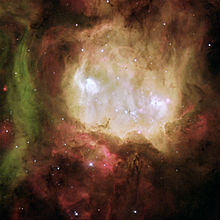astro.wikisort.org - Galaxy
NGC 2080 (The Ghost Head Nebula) is a star-forming region and emission nebula to the south of the 30 Doradus (Tarantula) nebula, in the southern constellation Dorado. It belongs to the Large Magellanic Cloud, a satellite galaxy to the Milky Way, which is at a distance of 168,000 light years.[1] NGC 2080 was discovered by John Frederick William Herschel in 1834.[2] The Ghost Head Nebula has a diameter of 50 light-years[3] and is named for the two distinct white patches it possesses, called the "eyes of the ghost".[4] The western patch, called A1, has a bubble in the center which was created by the young, massive star it contains. The eastern patch, called A2, has several young stars in a newly formed cluster, but they are still obscured by their originating dust cloud.[1][4] Because neither dust cloud has dissipated due to the stellar radiation, astronomers have deduced that both sets of stars formed within the past 10,000 years.[4] These stars together have begun to create a bubble in the nebula with their outpourings of material, called stellar wind.[5]
| Emission nebula | |
|---|---|
 A HST image of a Star-forming region NGC 2080. | |
| Observation data: J2000.0 epoch | |
| Right ascension | 05h 39m 44.2s |
| Declination | −69° 38′ 44″ |
| Distance | 160,000 ly |
| Constellation | Dorado |
| Designations | ESO 057-EN012, h 2950, GC 1278 |
The presence of stars also greatly influences the color of the nebula. The western portion of the nebula has a dominant oxygen emission line because of a powerful star on the nebula's outskirts; this colors it green.[4] The rest of the nebula's outskirts have a red hue due to the ionization of hydrogen.[4] Because both hydrogen and oxygen are ionized in the central region, it appears pale yellow; when hydrogen is energized enough to emit a second wavelength of light, it appears blue, as in the area surrounding A1 and A2.[1][4]
NGC 2080 should not be confused with the Ghost Nebula (Sh2-136) or the Little Ghost Nebula (NGC 6369).
See also
References
- Wilkins, Jamie; Dunn, Robert (2006). 300 Astronomical Objects: A Visual Reference to the Universe (1st ed.). Buffalo, New York: Firefly Books. ISBN 978-1-55407-175-3.
- Frommert, Hartmut; Kronberg, Christine (19 April 2006). "More LMC objects". SEDS. Retrieved 7 May 2012.
- Nemiroff, R.; Bonnell, J., eds. (31 October 2001). "Halloween and the Ghost Head Nebula". Astronomy Picture of the Day. NASA. Retrieved 7 May 2012.
- "Hubble Sends Season's Greetings from the Cosmos to Earth". HubbleSite. NASA and ESA. 19 December 2001. Retrieved 7 May 2012.
- "Painting with oxygen and hydrogen". ESA. 18 October 2001. Retrieved 7 May 2012.
External links
- NGC 2080 on WikiSky: DSS2, SDSS, GALEX, IRAS, Hydrogen α, X-Ray, Astrophoto, Sky Map, Articles and images
- SEDS
- Hubble Sends Season's Greetings from the Cosmos to Earth – Hubble Space Telescope news release
- NASA Astronomy Picture of the Day: Halloween and the Ghost Head Nebula (31 October 2001)
- Release on NGC 2080 at ESA/Hubble
На других языках
[de] NGC 2080
NGC 2080 ist ein Emissionsnebel mit einem eingebetteten offenen Sternhaufen im Sternbild Schwertfisch, der etwa 168.000 Lichtjahre von der Erde entfernt ist, er wird auch als Geisterkopfnebel bezeichnet. Er befindet sich in der Großen Magellansche Wolke, einer Begleitgalaxie unserer Milchstraße und steht etwa 30' südlich des bekannten Tarantelnebels (30 Doradus) am Himmel. Er wird wegen seines Aussehens auch Ghost Head Nebula oder zu deutsch Geisterkopf-Nebel genannt. Der Nebel ist Teil des N160-Komplexes in der großen Magellanschen Wolke und trägt als H-II-Gebiet auch die Bezeichnung N160A. Seine beiden Augen (N160A1 und N160A2) werden durch Blasen aus Wasserstoff und Sauerstoff gebildet (sogenannte High Excitation Blobs, HEBs), hinter denen sich massereiche Sterne verbergen. Nach Ansicht der Astronomen sollen sich diese Sterne vor etwa 10.000 Jahren gebildet haben. Der Nebel ist nicht mit den Objekten Geistnebel (VdB 141) oder Kleiner Geistnebel (NGC 6369) zu verwechseln.- [en] NGC 2080
[es] NGC 2080
NGC 2080 es una nebulosa de emisión visible en la Gran Nube de Magallanes, galaxia que forma parte del Grupo Local. Visualmente se encuentra en la constelación de Dorado, aproximadamente 30' al sur de la famosa nebulosa de la Tarántula (30 Doradus). Como región H II recibe el nombre de (LMC) N160A.[ru] NGC 2080
NGC 2080 (другое обозначение — ESO 57-EN12, N160A) — эмиссионная туманность в созвездии Золотой Рыбы, расположенная в Большом Магеллановом Облаке. Открыта Джоном Гершелем в 1834 году[2]. В туманности есть две ярких области, состоящих из кислорода и водорода: A1 и A2, звёзды в которых образовались в последние 10 тысяч лет. Область A1 подсвечивается одной яркой звездой, а область A2 — несколькими[3].Другой контент может иметь иную лицензию. Перед использованием материалов сайта WikiSort.org внимательно изучите правила лицензирования конкретных элементов наполнения сайта.
WikiSort.org - проект по пересортировке и дополнению контента Википедии